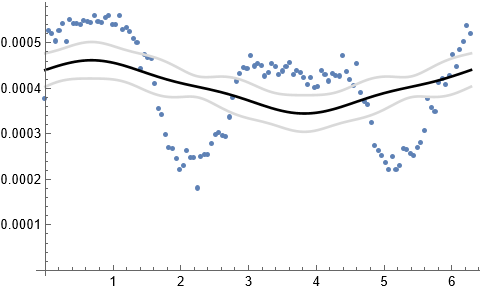If you just want to "describe" the data with a function (as opposed to obtaining a function with theoretically meaningful and interpretable parameters), then the answer from @DanialHuber is what you want. Here is an example with 4 terms of the form a[i] Sin[w[i] ϕ + θ[i]].
θ = {0, 0.05236, 0.10472, 0.15708, 0.20944, 0.2618, 0.31416, 0.36652, 0.41888, 0.47124, 0.5236, 0.57596, 0.62832, 0.68068, 0.73304, 0.7854, 0.83776, 0.89012, 0.94248, 0.99484, 1.0472, 1.09956, 1.15192, 1.20428, 1.25664, 1.309, 1.36136, 1.41372, 1.46608, 1.51844, 1.5708, 1.62316, 1.67552, 1.72788, 1.78024, 1.8326, 1.88496, 1.93732, 1.98968, 2.04204, 2.0944, 2.14675, 2.19911, 2.25147, 2.30383, 2.35619, 2.40855, 2.46091, 2.51327, 2.56563, 2.61799, 2.67035, 2.72271, 2.77507, 2.82743, 2.87979, 2.93215, 2.98451, 3.03687, 3.08923, 3.14159, 3.19395, 3.24631, 3.29867, 3.35103, 3.40339, 3.45575, 3.50811, 3.56047, 3.61283, 3.66519, 3.71755, 3.76991, 3.82227, 3.87463, 3.92699, 3.97935, 4.03171, 4.08407, 4.13643, 4.18879, 4.24115, 4.29351, 4.34587, 4.39823, 4.45059, 4.50295, 4.55531, 4.60767, 4.66003, 4.71239, 4.76475, 4.81711, 4.86947, 4.92183, 4.97419, 5.02655, 5.07891, 5.13127, 5.18363, 5.23599, 5.28835, 5.34071, 5.39307, 5.44543, 5.49779, 5.55015, 5.60251, 5.65487, 5.70723, 5.75959, 5.81195, 5.86431, 5.91667, 5.96903, 6.02139, 6.07375, 6.12611, 6.17847, 6.23083, 6.28319};
r2w = {0.000376, 0.000526, 0.00052, 0.000503, 0.000527, 0.000541, 0.000502, 0.000551, 0.000541, 0.000542, 0.000539, 0.000547, 0.000545, 0.000544, 0.000559, 0.000545, 0.000544, 0.000555, 0.000558, 0.000539, 0.00054, 0.00056, 0.000529, 0.000532, 0.000524, 0.000509, 0.000499, 0.000442, 0.000474, 0.000467, 0.000465, 0.000409, 0.000355, 0.000341, 0.000297, 0.000269, 0.000266, 0.000245, 0.00022, 0.000229, 0.000263, 0.000246, 0.000247, 0.00018, 0.000249, 0.000254, 0.000253, 0.000277, 0.000297, 0.000302, 0.000295, 0.000294, 0.000336, 0.000378, 0.000415, 0.000431, 0.000445, 0.000443, 0.000471, 0.000448, 0.000454, 0.000449, 0.000426, 0.000433, 0.000454, 0.000447, 0.00043, 0.000437, 0.000446, 0.000456, 0.000429, 0.000438, 0.000433, 0.000422, 0.000407, 0.000422, 0.0004, 0.000404, 0.000439, 0.00043, 0.000415, 0.000432, 0.000427, 0.000426, 0.000472, 0.000436, 0.000418, 0.000406, 0.000453, 0.000389, 0.000369, 0.000364, 0.000324, 0.000274, 0.000262, 0.000251, 0.000235, 0.00022, 0.00025, 0.000221, 0.000229, 0.000266, 0.000264, 0.000255, 0.000252, 0.000268, 0.00028, 0.000306, 0.000377, 0.000357, 0.000348, 0.000411, 0.000421, 0.000407, 0.000427, 0.000474, 0.000446, 0.000484, 0.000502, 0.000537, 0.000519};
DataR2w = Transpose[{θ, r2w}];
k = 4;
model = a0 + Sum[a[i] Sin[w[i] ϕ + θ[i]], {i, k}]
nlm = NonlinearModelFit[DataR2w, model,
Join[{{a0, Mean[DataR2w[[All, 2]]]}}, Flatten[Table[{a[i], w[i], θ[i]}, {i, k}]]],
ϕ, MaxIterations -> 10000];
Show[ListPlot[DataR2w], Plot[nlm[ϕ], {ϕ, 0, 2 π}, WorkingPrecision -> 20]]

If the proposed model is theoretically based and still desired to fit, then the fit is straightforward with NonlinearModelFit:
modelR2w = y1 + DL Cos[ϕ + a2] + FL (2 Cos[ϕ + a2]^3 - Cos[ϕ + a2]);
nlm = NonlinearModelFit[DataR2w, modelR2w, {y1, DL, a2, FL}, ϕ]
mpb = nlm["MeanPredictionBands"];
Show[ListPlot[DataR2w],
Plot[{nlm[ϕ], mpb}, {ϕ, 0, 2 π}, PlotStyle -> {Black, LightGray, LightGray}]]

This is not a good fit but not the fault of NonlinearModelFit. What appears to be missing is a parameter that @DanielHuber noticed and included. Rewriting the model with that missing parameter provides a much better fit but then doesn't show that the data likely resulted from such a model.
modelR2wx = y1 + DL Cos[w ϕ + a2] + FL (2 Cos[w ϕ + a2]^3 - Cos[w ϕ + a2]);
nlmx = NonlinearModelFit[DataR2w, modelR2wx, {y1, DL, a2, FL, {w, 0.7}}, ϕ]
mpbx = nlmx["MeanPredictionBands"];
Show[ListPlot[DataR2w],
Plot[{nlmx[ϕ], mpbx}, {ϕ, 0, 2 π}, PlotStyle -> {Black, LightGray, LightGray}]]








